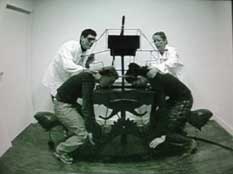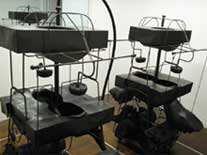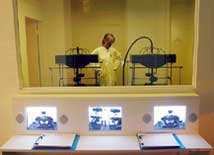 In Compassion, Lynda Abraham creates a behavioral science lab. The sculpture, designed for “two people who are hateful and hurtful towards one another,� is a black structure of pulleys, wheels, cables, seats and metal that bind two human subjects together over a water basin.
In Compassion, Lynda Abraham creates a behavioral science lab. The sculpture, designed for “two people who are hateful and hurtful towards one another,� is a black structure of pulleys, wheels, cables, seats and metal that bind two human subjects together over a water basin.
They are face to face and only the tips of their noses is touching water. Uncomfortable, each tries to pull their head further from the water, but in doing so (by the design of the device) their partner’s head will be submerged. Each will cause and witness the choking, gagging and struggling of the other. The struggle may continue for a while, as contempt transforms to compassion under the necessity to work together to end further suffering.
From another room, gallery visitors wearing lab coats are invited to observe the scene and in the absence of human subjects they can watch monitors displaying video archives of previous live-action performances involving the use of the Compassion device.

 Like exercise machines that invariably get stored in a corner promising overnight miracles, Abraham’s apparatuses have an added function: their mere presence creates guilt and rumination. They are a nagging reminder of the need for change. (…) By provoking empathy, Abraham’s elaborately designed experiences have the potential to harness negative social attitudes into positive social behavior.
Like exercise machines that invariably get stored in a corner promising overnight miracles, Abraham’s apparatuses have an added function: their mere presence creates guilt and rumination. They are a nagging reminder of the need for change. (…) By provoking empathy, Abraham’s elaborately designed experiences have the potential to harness negative social attitudes into positive social behavior.
“I made these sculptures to look like they are functioning prototypes made by someone in their basement for future manufacturing,” explains the artist. “Devices designed for the pursuit of human kindness.”
More in Brooklyn rail.
Related: Peter Marigold‘s Volume, a radio system in a bucket of water. The water level in the bucket controls the volume of the radio. From the outside you hear absolutely nothing. But once your ears are immersed in the water, you are submerged by the sound of the radio. Tested at my own risk at the Salone del Mobile in Milan last year.
